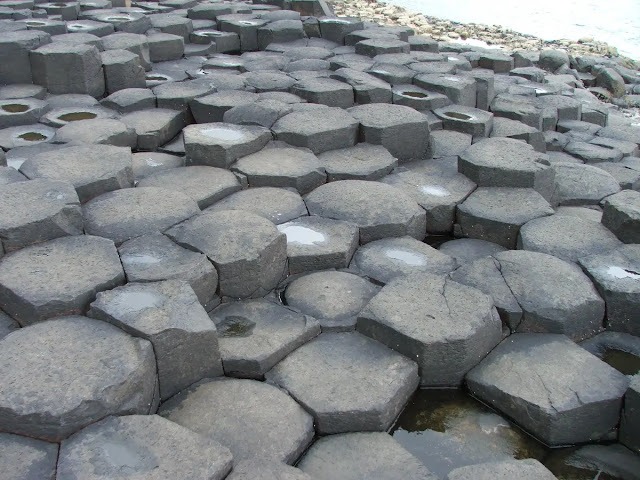The Difference Between Moonstone and Opalite
Moonstone and opalite are often mistaken for one another because both can display a luminous, glowing appearance. In reality, they are completely different materials. Moonstone is a natural mineral with a complex geological history, while opalite is an artificial glass designed to mimic gemstones.
 |
| Comparison of a polished moonstone cabochon, displaying blue adularescence, alongside a man-made opalite glass gemstone exhibiting a milky, internal glow. |
Geological Origin and Formation
Moonstone is a natural feldspar mineral, primarily composed of orthoclase (potassium feldspar) and albite (sodium feldspar). It forms in igneous and metamorphic rocks under conditions where feldspar crystallizes and undergoes exsolution—a process involving the separation of mineral phases during cooling, resulting in alternating microscopic layers of orthoclase and albite. This layered structure gives rise to the characteristic optical effect known as adularescence, a bluish or whitish sheen that appears to float beneath the stone's surface. Significant deposits of moonstone occur in Sri Lanka, India, Madagascar, Myanmar, and regions of the European Alps.
In contrast, opalite is not a natural mineral but a synthetic material, typically manufactured from glass fused with metal oxides to imitate the appearance of opal or moonstone. As an artificial product, it lacks a geological formation history and does not possess a crystalline mineral structure. The term "opalite" can be misleading, as it implies a relation to natural opal, yet it is unrelated to opal or feldspar minerals.
 |
| Rainbow Moonstone |
Mineral Composition and Structure
Moonstone: A potassium aluminum silicate with the chemical formula KAlSi₃O₈, exhibiting a crystalline structure. Certain varieties, such as "rainbow moonstone," are actually labradorite, a plagioclase feldspar.
Opalite: A non-crystalline glass, primarily composed of silica with variable additions of metal oxides. Manufacturing artifacts, such as bubbles or swirls, may be visible.
Optical Properties
The primary optical feature of moonstone is adularescence, characterized by a billowy, bluish to whitish glow that shifts with viewing angle. This effect arises from light interference and scattering between the thin, alternating feldspar layers.
Opalite exhibits a soft, diffused glow that appears blue in natural light and orange under intense illumination. Against dark backgrounds, it often presents a bluish hue, while under direct light, it may shift to golden or orange tones. This phenomenon results from light refraction and scattering within the glass matrix, rather than from crystalline layering.
Physical Properties
Transparency and Color
- Moonstone: Translucent to semi-transparent, with colors ranging from colorless, white, and gray to peach, brown, and green. Natural inclusions and textures are commonly present.
- Opalite: Typically milky white to clear, with a uniform appearance. It generally lacks inclusions and appears flawless, though manufacturing bubbles may occur.
 |
| Opalite synthetic glass cabochons. |
Hardness and Durability
- Moonstone: Rates 6–6.5 on the Mohs scale. It is relatively durable but susceptible to breakage along cleavage planes if impacted.
- Opalite: Rates 5–5.5 on the Mohs scale. It is softer than moonstone and more prone to chipping or scratching.
Uses and Value
Moonstone holds significant value as a gemstone and cultural artifact. It serves as one of the traditional birthstones for June and is associated with themes of love, intuition, and protection in various folklores. High-quality specimens with pronounced blue adularescence are prized in jewelry and can achieve premium market prices. Historically, moonstone has been utilized in adornments since ancient Roman and Indian civilizations, underscoring its mineralogical and cultural importance.
Opalite, while aesthetically pleasing, possesses considerably lower market value due to its mass production. It is commonly employed in inexpensive jewelry, carvings, and items for metaphysical purposes, where it is marketed for qualities such as serenity and energy enhancement. From a gemological perspective, however, it lacks the rarity, historical context, and natural significance of moonstone.
Key Differences at a Glance
Natural vs. Artificial: Moonstone is a natural feldspar; opalite is synthetic glass.
Optical Effect: Moonstone displays adularescence; opalite glows due to light scattering in glass.
Value: Moonstone is a collectible gemstone with cultural and mineralogical importance; opalite is inexpensive and decorative.
Structure: Moonstone has cleavage and natural inclusions; opalite is uniform and flawless.
Durability: Moonstone is harder but fragile along cleavage planes; opalite is softer and chips easily.
Read also:
Ammolite Gemstone with a Spectacular Flash of Iridescent Colors!
What is Adularescence?
How Do Asterism Minerals Form?



%20(1).webp)




